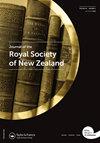在新西兰奥特罗阿,农村中学毕业生进入医学课程的成绩不平等
IF 2.1
4区 综合性期刊
Q2 MULTIDISCIPLINARY SCIENCES
引用次数: 0
摘要
教育文献表明,城乡在教育成就上存在差异。农村学校教育成绩较低可能影响进入竞争激烈的医疗项目,使农村学生处于不利地位。在这项研究中,国家教育成就证书(NCEA)和大学入学(UE)的获得率在2012-2021年新西兰奥特罗阿中学进行了比较。根据奥塔哥大学和奥克兰大学医学课程采用的两种农村入学方案,将高中分为城市或农村。计算了描述性统计数据,并创建了回归模型来调整一系列变量。数据显示,农村高中的NCEA和UE成绩较低。低Māori学生NCEA和UE成就,较大的社会经济劣势和不同的特征是城乡学校差异的主要原因。农村学校较低的教育普及率可能意味着农村学生进入医疗课程将面临更大的困难,这种不平等对农村Māori学生来说更为严重。为了解决农村劳动力问题,医疗方案入学途径需要进行根本性转变——从劳动力途径转向劳动力和公平途径。本文章由计算机程序翻译,如有差异,请以英文原文为准。
Rural secondary school leaver attainment inequities for students entering medical programmes in Aotearoa New Zealand
The education literature suggests that there are rural–urban differences in educational achievement. Lower educational achievement in rural schools may impact entry into highly competitive medical programmes and disadvantage rural students. Within this study, the National Certificate of Educational Achievement (NCEA) and University Entrance (UE) attainment rates are compared across Aotearoa New Zealand secondary schools for 2012–2021. High schools were classified as urban or rural according to the two rural admission schemes used in the medical programmes at the University of Otago and the University of Auckland. Descriptive statistics were calculated and regression models created to adjust for a range of variables. The data demonstrates that rural high schools have lower NCEA and UE attainment. Lower Māori student NCEA and UE attainment, greater socioeconomic disadvantage and differing characteristics account for the majority of differences between rural and urban schools. The lower UE attainment rate for rural schools will likely mean that rural students will have greater difficulty in entering medical programmes and that this inequity is worse for rural Māori students. Medical programme admission pathways need to undergo a fundamental shift–from workforce pathways to workforce and equity pathways in order to address rural workforce issues.
求助全文
通过发布文献求助,成功后即可免费获取论文全文。
去求助
来源期刊

Journal of the Royal Society of New Zealand
综合性期刊-综合性期刊
CiteScore
4.60
自引率
0.00%
发文量
74
审稿时长
3 months
期刊介绍:
Aims: The Journal of the Royal Society of New Zealand reflects the role of Royal Society Te Aparangi in fostering research and debate across natural sciences, social sciences, and the humanities in New Zealand/Aotearoa and the surrounding Pacific. Research published in Journal of the Royal Society of New Zealand advances scientific knowledge, informs government policy, public awareness and broader society, and is read by researchers worldwide.
 求助内容:
求助内容: 应助结果提醒方式:
应助结果提醒方式:


